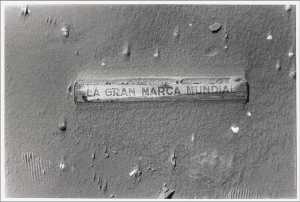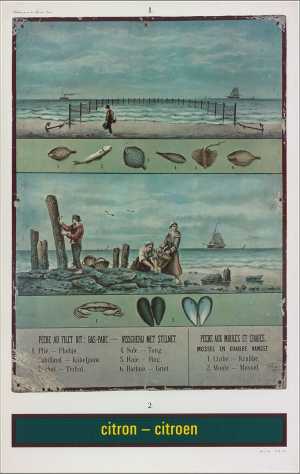In 1958, Broodthaers started publishing poems and articles, illustrated with his own photographs. His first solo exhibition was held in 1964 in Galerie St. Laurent in Brussels. In 1968 he opened the Museum for Modern Art in his own house in Brussels. In this 'museum' he exhibited postcards of paintings and transport boxes for art. Broodthaers investigates in his work how art functions in different contexts, for example that of the museum. Broodthaers is an important representative of conceptual art. Since 1969, Broodthaers has lived in places such as Dusseldorf, Berlin, Cologne and London.Marcel Broodthaers began his career after the Second World War as a poet. He moved in Surrealist circles and developed a great interest in photography and film, but discovered that he could not make a living from words and images. In 1964, at the Galerie St. Laurent in Brussels, he exhibited a work entitled Pense-bête (Reminder), comprising a collection of notebooks with poems held together with plaster, thus setting the tone for his future visual art practice. In all his subsequent works, Broodthaers undertook a humorous investigation of the relationship between words, objects and images.
In this way, he connected with the subject matter explored by his famous fellow countryman René Magritte. As a conceptual artist, Broodthaers questioned the scope of visual language, just as the Austrian philosopher Ludwig Wittgenstein had previously questioned the scope of written language.
Broodthaers gave a boost to the critical discussion about the role of art and, by extension, the role of museums. In 1968 he inaugurated the Musée d’Art Moderne, Département des Aigles – Section XIXe siècle (Museum of Modern Art, Department of Eagles, 19th-Century Section) in his house on the Rue de Pépinière in Brussels. Instead of displaying art objects, he showed reproductions and boxes with printed words suggesting that they contained artworks. He subsequently installed various departments of this ‘museum’ in venues around the world.
Between 1957 and 1976, Broodthaers made around fifty films, all but one of was acquired by the museum. The films do not stand alone but are a meeting point for poetry and visual art. His first published poem from 1948 is entitled ‘Projet pour un film’, his 1957 film La clef de l’horloge pays homage to Kurt Schwitters, and for his 1967 film Le corbeau et le renard he made a projection screen on which words from a poem are painted.

Marcel Broodthaers
Brussel 1924 - Keulen 1976

















